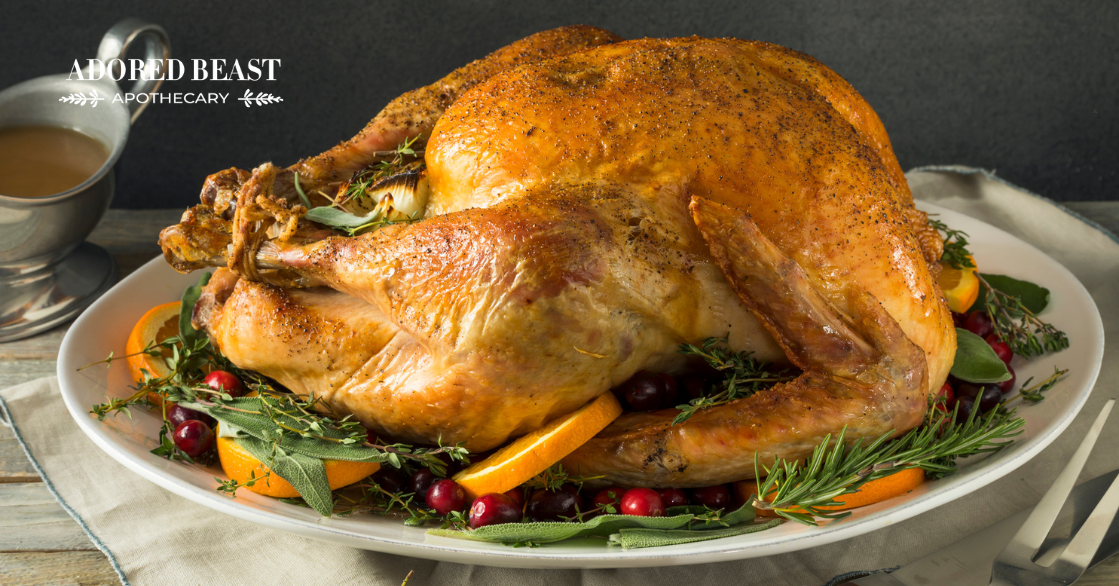When it comes to food, we love equations! We count calories, calculate daily nutrients, measure out ingredients. This obsession with numbers is even more notable in the pet world, where nutrient requirements seems to be the primary metric for food adequacy (i.e. AAFCO), largely ignoring ingredient quality, processing, and other factors.
But when it comes to the equation between food and stress, things often don’t add up! When it comes to the equation between food and stress, pets are ending up in the red….
The Link Between Food and Stress
A diet is more than just a collection of nutrients. Food is intended to be a positive experience for both people and pets. Food is supposed to provide energy and nutrients for the body, support the immune system and bring pleasure, security and happiness through the process of eating. It is also a social experience that can often bring us together. Yet, many foods we feed our pets today do the exact opposite – they are making our pets sick with stress. Food-related stress can affect not only your pet’s physical health but also their mental well-being and even behavior.
Not all stress has negative effects. Studies show that short-term stress boosts immune function, but chronic stress has a negative effect on the immune system that ultimately manifests as illness. In people, prolonged chronic stress can lead to several serious diseases including heart disease, stroke, diabetes, and cancer. It is not unreasonable to assume that the same would apply to pets.
This kind of stress is like water dripping on rock – over time, it weakens every system in the body, paving the way for disease.
Sarah Griffiths had a great example of this from her client’s dog:
“She was very picky with food (which is alarming on its own given she is a lab cross – a breed well known for its love of all things food) and wouldn’t eat her dry food (one of the more expensive brands on the market). The owner would put the food in the bowl and put it down for her. She would look in the bowl and gingerly eat a few kibbles with her tail down, put her head down and then walk away from the bowl, still full of food.
After working with this client for a while, I finally convinced him to allow me to offer her raw food. The change was dramatic – she danced around the kitchen even before the food hit the floor, jumping up and down whining and then scarfed it down like a wolf. The behavior was significantly different and showed the dog was clearly stressed and hating the food that was being offered before.”
It would have been easy to dismiss this dog as just another picky eater. But ignoring the signs of food stress would have led to other more severe symptoms and health issues over time.
Because each dog and cat is unique, the symptoms of chronic food-related stress show up in different ways. Some are severe, some are subtle. This makes it easy for people to overlook the physical and behavioral signs. But make no mistake, they are your pet’s EARLY WARNING SYSTEM for the storm that is brewing inside. Too often, we treat the symptoms without addressing the underlying cause. It is like turning off your beeping smoke alarm in your house and going back to bed instead of looking for a fire. Supressing the physical symptom or trying to fix the behavior without addressing the underlying cause will lead to it manifesting in a different and usually more severe way.
Food Stress #1: Highly Processed Food
The most common food-related stressors for dogs and cats are highly processed dry foods, especially those high in carbohydrates and sugars. Many processed dry pet foods today are processed with high heat and some use ingredients that are not fit for human consumption (they should really be called “feed”, not “food”). While these diets may meet the minimal level of nutrients required by AAFCO, they often don’t provide the body with sufficient levels of essential nutrients to help your pet manage stress daily. Furthermore, digesting complex low-quality foods actually further strains physiological systems.
For example, fats are an essential nutrient for our pets and provide energy, support the brain and many other functions. High-heat processing chemically changes these fats. This means that some foods can be lacking in essential fats like Omega-3, critical nutrients for brain development, cognitive learning, and management of inflammatory responses in the body. Sadly, some essential fatty acids are not even recognized as essential nutrients by AAFCO. Some companies recognize this challenge add extra Omega-3 to the food. However, because these fats are very fragile, they often degrade in quality quickly once the bag is opened.
Dry foods can put stress on the kidneys due to the lack of moisture (which is also conspicuously missing from AAFCO’s list of essentials). Processed diets containing legumes and beans as a main protein source may contribute to cardiac stress due to lack certain essential amino acids.
Another huge challenge are those high levels of carbohydrates and sugars. It is now a well-established fact (for human nutrition) that consuming high amounts of sugar consistently contributes to chronic inflammation. Inflammation is part of the body’s normal defense mechanism. It is the process by which the immune system recognizes and removes harmful and foreign stimuli and begins the healing process. However, prolonged chronic inflammation can lead to a wide range of serious debilitating diseases. Sugar can also weaken your body’s ability to respond to stress. Now, you may be thinking “sugar is not an ingredient in my pet food” but here is the problem – highly processed carbohydrates or starches get converted into sugars.
Highly processed food can have a significantly negative affect on the gut microbiome. The microbiome plays a critical role in health. Bacteria in the microbiome helps digest food, regulate the immune system, protect against other bacteria that cause disease, produce vitamins and much more. Imbalance in the microbiome can create stress throughout the body. An imbalance of gut bacteria can produce stress in the brain and can also contribute to further inflammation. We could literally write a whole article just on this …
Finally, highly processed foods often contain additives and preservatives to ensure they can stay on a shelf for many years. These chemicals can create toxic stress and damage to organs and the gut microbiome.
We could keep going but you get the point …

Food Stress #2: Stressed Meat
Another notable contributor to food-related stress is the meat that goes into the food. To put it simply, if the animal meat that is in your pet’s food (cow, pig, lamb, etc.) was stressed at the time of slaughter, then they were producing high levels of the stress hormone cortisol. Some animals may have also been given growth hormones to maximize meat yield. These hormones stay in the meat and get passed through the food system to your pet. While studies are still in the early phases on connecting health with hormones in meat, many health experts believe that consuming meat with stress hormones can increase inflammation, stress, and anxiety.
Food Stress #3: The Same Food Every Day
Stress is not only physical. Mental stress is just as real for our pets as it is for us. Some animal experts believe that the way we feed our pets today is adding to their mental stress and suppressing their natural behaviors. For example, pets are eating THE. SAME. EXACT. FOOD. EVERY. SINGLE. DAY. Imagine how you would feel if you had to do this? Imagine getting the same dry nuggets day in and day out… Imagine the stress you would feel surrounding the act of eating. Imagine the struggle between the feeling of starvation and the feeling of nausea from eating. This might be more stressful than all the other points we’ve made so far. Variety is the spice of life, right? You can improve picky pet behavior, reduce stress, and increase vitality all with feeding your pet some variety!
Stopping the Cycle of Physical and Mental Stress
Physiological and mental effects of prolonged chronic stress often create a self-feeding loop that can be difficult to break. The brain and body are so interconnected for people and pets that a chronic imbalance in one system can trigger an imbalance in other areas. For example, a pet may be picky about their food because eating it causes them physical discomfort, but this feeling, over time, leads to mental depression. The frustration around eating can be stressful, triggering the release of cortisol, which creates further physical inflammation and furthers the cycle.
In order to help your pet, you need to break this cycle by identifying and treating the primary stressor, and also the other affected systems.
This will take time, patience and lots of love (which also happens to be one of the pieces that can help your pet with their mental stress).

How to Stop the Cycle
If your pet is stuck in the stress loop, here is what you can do to help them:
- RELAX! You pass your stress on to your pet, which will undermine all your efforts.
- Quality Over Quantity. You can feed less food if you feed good food. Try to feed a variety of fresh foods as much as possible and reduce carbohydrates and sugars.
- Meat to thrive. Try to feed as much free-range, ethically raised meats as possible to reduce the risk of hormones passing to your pet.
- Add Omega-3s. Some great sources are fatty fish like salmon or sardines (you can used fresh or canned in water) or flax butter/whole flax seeds. Omega-3 fats reduce inflammation and balance out pro-inflammatory fats like Omega-6. Aim for a 4:1 ideal ratio. These fats are best served fresh and oxidize very quickly so even if the food you are feeding claims to have some, we recommend you add more!
- Probiotics and Fermented Foods. A healthy gut = a healthy mind and body. Probiotics can literally help change behaviour AND they produce important nutrients, antioxidants and enzymes to help the body function optimally.
- Give them a bone. Bone chewing is can help reduce boredom and reduce stress and anxiety for your dog. For many dogs (and some cats) it makes them incredibly happy!
Food and Bonding
Human beings and dogs form an intense and close bond of friendship, which is rarely seen in other species. Like people, dogs are very sociable animals and millennia of domestication have encouraged the creation of this type of close bond with their owner. Historically, both species have used food as a social bonding tool. Food and eating can be a happy and fulfilling process for a dog and many owners enjoy rewarding their pet’s loyalty with food, which builds the bond. However, when food becomes a stressful experience that creates anxiety, it can also negatively impact the bonding experience with our pet. We encourage and challenge you to focus on making the food experience an intentionally enjoyable bonding process for both you and your pet.
We can’t stress it enough (see what we did there?): food is the foundation for a stress-free life. Make your food choices for your pet count!












